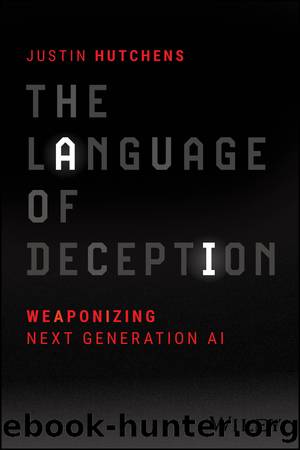The Language of Deception by Hutchens Justin;McClure Stuart;

Author:Hutchens, Justin;McClure, Stuart; [Hutchens, Justin]
Language: eng
Format: epub
Publisher: John Wiley & Sons, Incorporated
Published: 2024-01-04T00:00:00+00:00
The Spontaneous and Organic Occurrence of Turing Tests
A study conducted in 2022 found that the average American checks their phone 352 times a dayâthe equivalent of checking once every 2 minutes and 43 seconds. This study also indicated that this is nearly a four-fold increase since the same study had been conducted four years prior, in 2019 (Asurion, 2023). In our modern world, people are constantly checking their mobile devices for notifications or alerts. These alerts most commonly pertain to text messages, email, or engagement from other users on social media. And when receiving any of these alerts, and especially if they relate to interactions with somebody new, it is not unreasonable for a person to question whether they are interacting with a person or a bot.
Bots have existed among us for decades now. They have become so prevalent that their presence on the Internet nearly rivals our own. Cybersecurity firm Imperva released its 10th annual bad bot report in 2023. The report concluded that nearly half of all the network traffic on the Internet (approximately 47 percent) originated from bots, rather than humans (Imperva, 2023).
Alan Turing's imitation game (the Turing test) was originally conceived of as a purely academic exercise, to be conducted in a lab or a controlled testing environment. However, after multiple decades of persistent exponential advancement in technology, we have found ourselves in a world in which Turing tests can, and often do, occur organically. And by this, I do not use the term âorganicallyâ to reference events pertaining to living matter (though there is no doubt an irony in that alternate meaning), but rather, I mean that these events occur without being planned or deliberately orchestrated within a controlled settingâas was originally intended when proposed by Turing. These Turing tests no longer occur as a deliberate exercise of scientific inquiry, but instead are the product of unintentional encounters with bots, within the context of our routine day-to-day lives. We can attribute this phenomenon primarily to two distinct factors of technological advancement.
First, there has been a dramatic increase in digital text-based communications within the past decades. Since the late 1900s, we have witnessed the rapid evolution and adoption of multiple forms of technology that have enabled text-based communication between parties. In the current era, text-based communications are everywhere, including email, SMS text messaging, discussion forums, social media, messaging apps, dating sites, microblogging, business productivity suites, technical support chat clients, and many others.
Second, and in addition to the increase in text-based communications, scripting and coding have made it possible to effectively automate many of these interactions. These advances in automation technology have made it possible for individuals to create their own âbotsâ with minimal technical knowledge. These bots have the ability to masquerade as humans on digital platforms, engaging in the same activities that humans engage in but automated through predefined and scripted procedures.
In the past, there have been reasonably effective ways to determine whether systems that you interact with online are humans or machines. Less sophisticated
Download
This site does not store any files on its server. We only index and link to content provided by other sites. Please contact the content providers to delete copyright contents if any and email us, we'll remove relevant links or contents immediately.
In-Memory Analytics with Apache Arrow by Matthew Topol(2732)
PostgreSQL 14 Administration Cookbook by Simon Riggs(2271)
Cloud Auditing Best Practices: Perform Security and IT Audits across AWS, Azure, and GCP by building effective cloud auditing plans by Shinesa Cambric Michael Ratemo(2227)
Architects of Intelligence_The Truth About AI From the People Building It by Martin Ford(1280)
In-Memory Analytics with Apache Arrow: Perform fast and efficient data analytics on both flat and hierarchical structured data by Matthew Topol(1087)
Mastering Azure Virtual Desktop: The Ultimate Guide to the Implementation and Management of Azure Virtual Desktop by Ryan Mangan(1064)
Automated Machine Learning in Action by Qingquan Song Haifeng Jin Xia Hu(967)
Python GUI Programming with Tkinter, 2nd edition by Alan D. Moore(923)
Learn Wireshark - A definitive guide to expertly analyzing protocols and troubleshooting networks using Wireshark - 2nd Edition (2022) by Packt(803)
Ansible for Real-Life Automation - A complete Ansible handbook filled with practical IT automation use cases (2022) by Packt(793)
Legal Theory, Sources of Law and the Semantic Web by A. Boer(742)
Data Engineering with Scala and Spark by Eric Tome Rupam Bhattacharjee David Radford(477)
Introduction to Algorithms, Fourth Edition by unknow(446)
ABAP Development for SAP HANA by Unknown(398)
Automated Machine Learning in Action by Qingquan Song & Haifeng Jin & Xia Hu(361)
Kubernetes Secrets Handbook by Emmanouil Gkatziouras | Rom Adams | Chen Xi(327)
The AWK Programming Language by Aho Alfred V. Kernighan Brian W. Weinberger Peter J. & Brian W. Kernighan & Peter J. Weinberger(324)
Asynchronous Programming in Rust by Carl Fredrik Samson;(301)
Learn Enough Developer Tools to Be Dangerous: Git Version Control, Command Line, and Text Editors Essentials by Michael Hartl(296)
